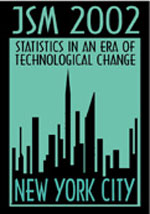|
Title
|
|
* ! Multiscale Raster Map Analysis System for Digital Government in the 21st Century
|
|
Date / Time / Room
|
Sponsor
|
Type
|
08/13/2002
2:00 PM -
3:50 PM
Room: S-Royal Ballroom B
|
ENAR, Environmental and Ecological Statistics, Section on Statistics & the Environment*
|
Invited
|
|
Organizer:
|
Ganapati P. Patil, Pennsylvania State University
|
|
Chair:
|
Ganapati P. Patil, Pennsylvania State University
|
|
Discussant:
|
|
|
Floor Discussion
|
3:20 PM
|
Description
Geospatial and remote sensing information has been a vastly under-utilized technological resource. Information technology for space imaging and mapping is now a challenge and opportunity for sustainable environment and development. Geospatial information technology is increasingly becoming the driving force for decision making across the local to regional to global continuum.
Consider an imminent 21st Century scenario: What message does a remote sensing-derived landcover landuse map have about the large landscape it represents? And at what scale and at what level of detail?...Does the spatial pattern of the map reveal any societal, ecological, environmental condition of the landscape? And therefore can it be an indicator of change?...How do you automate the assessment of the spatial structure and behavior of change to discover critical areas, hot spots, and their corridors?...Is the map accurate? How accurate is it? How do you assess the accuracy of the map? Of the change map over time for change detection? What are the implications of the kind and amount of change and accuracy on what matters, whether climate change, carbon emission, water resources, urban sprawl, biodiversity, indicator species, or early warning? And with what confidence, even with a single map/change-map?...The proposed session will discuss landscape-level-indicators-based answers to these questions that involve multicategorical raster maps based on remote sensing and other geospatial data, with applications to sustainable environment and development at watershed-based landscape scales.
Landscape pattern has become a topic of growing scientific attention, but most of the work to date has been of a descriptive character. The proposed session will provide a model-based inferential capability for landscape pattern comparison and analysis. It will provide information technology based decision science support for informed choices on geospatial resource issues. The session will provide a welcome innovation to model, simulate, compare, and analyze categorical raster data and also discuss the much needed initial methodological toolbox, computational toolkit, and visualization facility to automate the analysis of thematic raster maps of large size with objectivity and with statistical inferential capability.
The concepts, issues, methods, techniques, tools, and softwares involved will be presented and discussed, such as: multiscale landscape fragmentation profiles, conditional entropy profiles, heirarchical transition matrix models, echelon analysis for critical areas and corridors, pattern-based compression and segmentation, map and change map accuracy assessment and detection, etc. For additional information, see the following webpage and the cited references: www.stat.psu.edu/~gpp/newpage11.htm
|
|

